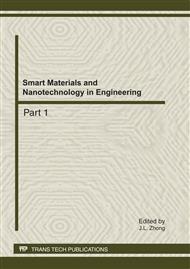[1]
S. M. Grundy, J. I. Cleeman, and C. N. Bairey Merz, Implications of recent clinical trials for the national cholesterol education program adult treatment panel III guidelines, Journal of the American College of Cardiology, vol. 44, no. 3, pp.720-732, (2004).
DOI: 10.1016/j.jacc.2004.07.001
Google Scholar
[2]
D. Kromhout, A. Menotti, H. Kesteloot and S. Sans, Prevention of coronary heart disease by diet and lifestyle: evidence from prospective cross-cultural, cohort, and intervention studies, Circulation, vol. 105, no. 7, pp.893-898, (2002).
DOI: 10.1161/hc0702.103728
Google Scholar
[3]
R. Fuller, Probiotics in man and animals, Journal of Applied Bacteriology, vol. 66, no. 5, pp.365-378, (1989).
Google Scholar
[4]
A. Patel, R. Singhania, A. Pandey and S. Chincholkar, Probiotic bile salt hydrolase: current developments and perspectives, Applied Biochemistry and Biotechnology, vol. 162, pp.166-180, (2010).
DOI: 10.1007/s12010-009-8738-1
Google Scholar
[5]
I. De Smet, P. De Boever and W. Verstraete, Cholesterol lowering in pigs through enhanced bacterial bile salt hydrolase activity, British Journal of Nutrition, vol. 79, no. 2, pp.185-194, (1998).
DOI: 10.1079/bjn19980030
Google Scholar
[6]
T. D. T. Nguyen, J. H. Kang and M. S. Lee, Characterization of Lactobacillus plantarum PH04, a potential probiotic bacterium with cholesterol-lowering effects, International Journal of Food Microbiology, vol. 113, no. 3, pp.358-361, (2007).
DOI: 10.1016/j.ijfoodmicro.2006.08.015
Google Scholar
[7]
D. I. A. Pereira, A. L. McCartney and G. R. Gibson, An in vitro study of the probiotic potential of a bile-salt-hydrolyzing Lactobacillus fermentum strain, and determination of its cholesterol-lowering properties, Applied and Environmental Microbiology, vol. 69, no. 8, pp.4743-4752, (2003).
DOI: 10.1128/aem.69.8.4743-4752.2003
Google Scholar
[8]
R. Hartemink, V. R. Domenech and F. M. Rombouts, LAMVAB - A new selective medium for the isolation of lactobacilli from faeces, Journal of Microbiological Methods, vol. 29, no. 2, pp.77-84, May (1997).
DOI: 10.1016/s0167-7012(97)00025-0
Google Scholar
[9]
R. Hartemink, B. J. Kok, G. H. Weenk and F.M. Rombouts, Raffinose-bifidobacterium (RB) agar, a new selective medium for bifidobacteria, Journal of Microbiological Methods, vol. 27, no. 1, pp.33-43, (1996).
DOI: 10.1016/0167-7012(96)00926-8
Google Scholar
[10]
L. A. Devriese, J. Hommez, B. Pot and F. Haesebrouck, Identification and composition of the streptococcal and enterococcal flora of tonsils, intestines and faeces of pigs, Journal of Applied Microbiology, vol. 77, no. 1, pp.31-36, (1994).
DOI: 10.1111/j.1365-2672.1994.tb03040.x
Google Scholar
[11]
E. K. Mitsou, E. Kirtzalidou, I. Oikonomou, G. Liosis and A. Kyriacou, Fecal microflora of Greek healthy neonates, Anaerobe, vol. 14, no. 2, pp.94-101, (2008).
DOI: 10.1016/j.anaerobe.2007.11.002
Google Scholar
[12]
W. Swobodnik, U. Klüppelberg, J. G. Wechsler, M. Volz and G. Normandin, Rapid and accurate reversed-phase high-performance liquid chromatographic determination of conjugated bile acids in human bile for routine clinical applications : Therapeutic control during gallstone dissolution therapy. Journal of Chromatography B: Biomedical Sciences and Applications, vol. 339, pp.263-271, (1985).
DOI: 10.1016/s0378-4347(00)84653-8
Google Scholar
[13]
S. J. Kim, et al. Effect of microencapsulation on viability and other characteristics in Lactobacillus acidophilus ATCC 43121,. LWT-Food Science and Technology, vol. 41, no. 3, pp.493-500, (2008).
DOI: 10.1016/j.lwt.2007.03.025
Google Scholar
[14]
S. Swain, C. Singh and V. Arul. Inhibitory activity of probiotics Streptococcus phocae PI80 and Enterococcus faecium MC13 against Vibriosis in shrimp Penaeus monodon,. World Journal of Microbiology and Biotechnology, vol. 25, no. 4, pp.697-703, (2009).
DOI: 10.1007/s11274-008-9939-4
Google Scholar
[15]
Z. Zeng, J. Lin and D. Gong, Identification of lactic acid bacterial strains with high conjugated linoleic acid-producing ability from natural sauerkraut fermentations, Journal of Food Science, vol. 74, no. 4, pp. M154-M158, (2009).
DOI: 10.1111/j.1750-3841.2009.01123.x
Google Scholar
[16]
T. Li and J. Y. L. Chiang, Regulation of bile acid and cholesterol metabolism by PPARs, PPAR Research, vol. 2009, p.501739, (2009).
DOI: 10.1155/2009/501739
Google Scholar
[17]
B. Z. De Rodas, S. E. Gilliland and C. V. Maxwell, Hypocholesterole-mic action of Lactobacillus acidophilus ATCC 43121 and calcium in swine with hypercholesterolemia induced by diet, Journal of Dairy Science, vol. 79, no. 12, pp.2121-2128, (1996).
DOI: 10.3168/jds.s0022-0302(96)76586-4
Google Scholar
[18]
E. Tuomola, R. Crittenden, M. Playne, E. Isolauri and S. Salminen, Quality assurance criteria for probiotic bacteria, American Journal of Clinical Nutrition, vol. 73, no. 2, pp. 393s-398s, (2001).
DOI: 10.1093/ajcn/73.2.393s
Google Scholar
[19]
N. J. Jordan, G. Kolios, S. E. Abbot, M. A. Sinai and D. A. Thompson, Expression of functional CXCR4 chemokine receptors on human colonic epithelial cells, The Journal of Clinical Investigation, vol. 104, no. 8, pp.1061-1069, (1999).
DOI: 10.1172/jci6685
Google Scholar
[20]
S. E. Gilliland, T. E. Staley, and L. J. Bush, Importance of bile tolerance of Lactobacillus acidophilus used as a dietary adjunct, Journal of Dairy Science, vol. 67, no. 12, pp.3045-3051, (1984).
DOI: 10.3168/jds.s0022-0302(84)81670-7
Google Scholar
[21]
W. H. Holzapfel, P. Haberer, J. Snel and U. Schillinger, Overview of gut flora and probiotics, International Journal of Food Microbiology, vol. 41, no. 2, pp.85-101, (1998).
DOI: 10.1016/s0168-1605(98)00044-0
Google Scholar
[22]
S. Ruiz-Moyano, A. Martín, M. J. Benito, F. P. Nevado and M. de Guía Córdoba, Screening of lactic acid bacteria and bifidobacteria for potential probiotic use in Iberian dry fermented sausages, Meat Science, vol. 80, no. 3, pp.715-721, (2008).
DOI: 10.1016/j.meatsci.2008.03.011
Google Scholar
[23]
Y. Huang and M. C. Adams, In vitro assessment of the upper gastro-intestinal tolerance of potential probiotic dairy propionibacteria, International Journal of Food Microbiology, vol. 91, no. 3, pp.253-260, (2004).
DOI: 10.1016/j.ijfoodmicro.2003.07.001
Google Scholar


